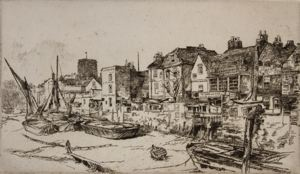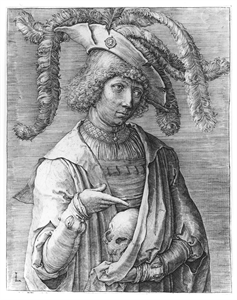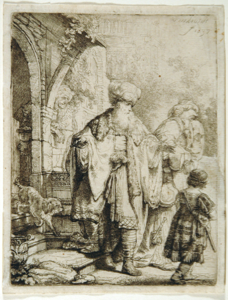
James Abbott McNeill Whistler
American, 1834–1903
For this densely etched image of structures along the waterfront of the River Thames, Whistler may have worked from memory or a photograph. By the time he created the etching, some of these structures had been demolished and rebuilt. A growing nostalgia for the quaint old buildings may have influenced Whistler to emphasize their picturesque character. He showed the area’s reliance on the river by prominently placing moored boats in the foreground. However, he included no figures, which removed the sense of everyday life that had been central to the etchings of his earlier Thames Set, while adding a degree of timelessness to the scene. Masses of hatching and crosshatching establish the dark values in the shadows of the piers, the facades, and the roofs, but Whistler no longer felt compelled to draw every detail. He relied more on suggestion, evoked by shadows and small but significant details. Whistler’s handling of pictorial space grows from his shift from realism to a more fluid technique, and this print manifests that transition from the linear nature of his early etchings towards the decidedly atmospheric handling of his Venetian prints of 1879-1880.
See Fleeting Impressions: Prints by James McNeill Whistler, exh. cat. (Montgomery: Montgomery Museum of Fine Arts, 2006), 47.
American, 1834–1903
The "Adam and Eve", Old Chelsea
1879
Object Type:
Print
Creation Place:
North America, American
Dimensions:
6 15/16 in. x 12 in. (17.62 cm x 30.48 cm)
Medium and Support:
Etching on laid paper
Accession Number:
1984.0017.0017
Credit Line:
Gift of Mr. and Mrs. Adolph Weil, Jr., in memory of Mr. and Mrs. Adolph Weil, Sr.
For this densely etched image of structures along the waterfront of the River Thames, Whistler may have worked from memory or a photograph. By the time he created the etching, some of these structures had been demolished and rebuilt. A growing nostalgia for the quaint old buildings may have influenced Whistler to emphasize their picturesque character. He showed the area’s reliance on the river by prominently placing moored boats in the foreground. However, he included no figures, which removed the sense of everyday life that had been central to the etchings of his earlier Thames Set, while adding a degree of timelessness to the scene. Masses of hatching and crosshatching establish the dark values in the shadows of the piers, the facades, and the roofs, but Whistler no longer felt compelled to draw every detail. He relied more on suggestion, evoked by shadows and small but significant details. Whistler’s handling of pictorial space grows from his shift from realism to a more fluid technique, and this print manifests that transition from the linear nature of his early etchings towards the decidedly atmospheric handling of his Venetian prints of 1879-1880.
See Fleeting Impressions: Prints by James McNeill Whistler, exh. cat. (Montgomery: Montgomery Museum of Fine Arts, 2006), 47.
Keywords
Click a term to view the records with the same keyword
Portfolio List
Click a portfolio name to view all the objects in that portfolio
This object is a member of the following portfolios:
Your current search criteria is: Keyword is "NO" and [Object]Display Artist is "James Abbott McNeill Whistler".

